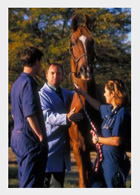Equine Piroplasmosis
Request to Receive Animal Disease SMS Text Alerts
Equine piroplasmosis is a blood-borne disease of equids (horses, donkeys, mules and zebras) caused by one of two protozoan parasites, Theileria equi or Babesia caballi. The United States is considered "free" of this disease. Positive cases must be reported to state or federal animal health officials.
Natural transmission occurs when a tick consumes a bloodmeal from an infected horse and transfers the parasite to a naïve horse or to subsequent generations of ticks. Species of ticks capable of transmitting the causative organisms are naturally found in the United States. Additionally, an infected pregnant mare may pass the organism to her foal in utero.
Iatrogenic transmission via the use of infected blood or blood products, or by the use of blood contaminated equipment such as needles, syringes, surgical instruments, dental equipment, tattooing equipment, or any other equipment may spread the disease to a naïve horse.
Clinical Signs
After an incubation period of five to twenty eight days, clinical signs may include fever, anemia, yellowing of the mucous membranes (jaundice), dark brown or red-tinged urine, collapse and death in severe cases.
A horse that survives the clinical phase of the disease continues to carry parasite in their red blood cells. These persistently infected horses pose a risk for infection to other horses. Stress, such as racing, heavy exercise, or transport, may increase the levels of parasite present in the blood of the infected horse, thereby increasing the risk of disease spread.
Diagnosis
Equine piroplasmosis is diagnosed by serologic test. In the United States, testing is performed by complement fixation (CF) and enzyme-linked immunodiffusion antibody (ELISA) test for both causative organisms. Tests are used in parallel, as CF more readily detects acute disease while ELISA is more sensitive for detecting chronic infection.
Regulatory Considerations
Positive tests are reported by the testing laboratory to the local state or federal animal health official. The positive horse will be placed under quarantine by a California Department of Food and Agriculture (CDFA) Animal Health Official. Options for a test positive horse are enrollment into the United States Department of Agriculture Animal and Plant Health Inspection Service (USDA APHIS) equine piroplasmosis treatment research program, lifetime quarantine or euthanasia.
All exposed horses will also be tested for the disease. An exposed horse is any horse that has shared close contact with an infected horse, may have become infected by the use of shared needles, syringes, dental, surgical or tattooing equipment or is the nursing offspring of a positive or exposed horse. Exposed horses will be placed under quarantine and retested after forty five (45) to sixty (60) days for the disease. Should they be found negative at that time, the quarantine will be released.
Treatment and Prognosis
A treatment has been recently developed to treat Theileria equi infections. Positive horses can be enrolled in a state-federal approved treatment program. Treatment with an antiprozoal drug, imidocarb, is performed at the owner’s expense and must be performed by a USDA accredited veterinarian under the observation of a state or federal animal health official. The horse is quarantined for the entire length of treatment.
Prevention
This is a blood-borne disease. In order to protect horses from getting this disease:
- Always use a sterile needle and syringe for all injections, into a vein, muscle or skin.
- Disinfect all dental, tattooing and surgical equipment between horses. Make sure to remove all debris and blood with soap and water before disinfection.
- Only administer commercially licensed blood products.
- Use a sterile needle each time when puncturing a multi-dose medication bottle. Consult a veterinarian to demonstrate how to use sterile technique when drawing up medications.
- Monitor for the presence of ticks on your horses. If ticks are found, consult a veterinarian as to the best tick-prevention approaches in your area.
- Contact a veterinarian if a horse shows signs of fever, jaundice, decreased appetite or weight loss.
Equine Resources
More Resources
Contact Us
CDFA Animal Health and Food Safety Services,
Animal Health Branch
Sacramento, California 95814
Phone: 916-900-5002
Fax: 916-900-5333
Email: ahbfeedback@cdfa.ca.gov


